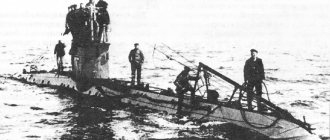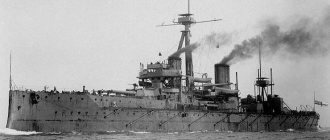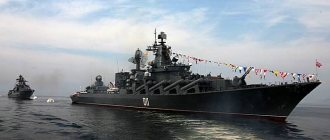The first submarine in Russia was created under Peter I. The designer was Efim Prokopyevich Nikonov. In 1718, he submitted a petition to the emperor, in which he promised to create a completely new ship. He claimed that he would create a boat that would destroy dozens of enemy ships. The emperor agreed, but ordered everything to be done in secret. Two years later, a prototype was created, and a couple of years later, a full-size vessel. This is how the history of our submarine fleet began. From this material you will learn about the first Russian submarine and those ships that appeared after it.
The description of the first submarine looks primitive compared to modern models, but this is a story, without which there would be nothing subsequent. She was the first not only in Russia, but throughout the world.
Long way underwater
People made the first attempts to create devices for launching under water in ancient times. The flight of fancy was limited by technical capabilities, which until the 19th century did not allow the creation of any serious self-propelled underwater ship. With the development of science and engineering and the emergence of new instrumental capabilities, humanity gradually began to approach its cherished goal. At the forefront of technological progress, as often happens, were the military - for some reason their ideas found support more easily among those in power.
Photo: commons.wikimedia.org
General Karl Schilder, between 1858 and 1861
It is believed that the first domestic underwater vehicle was designed in the 30s of the 19th century by Karl Andreevich Schilder, a hereditary officer, a veteran of the Napoleonic wars, by that time already a general and chief of engineers of the Guards Corps. There is information that, armed with a mine on a pole and equipped with a periscope (for the first time in the world!), an all-metal boat with a rowing propulsion confidently passed tests in the presence of the imperial commission, but Nicholas I, not inclined to innovation, did not want to put a fundamentally new weapon into production. The project was closed, the boat was scrapped, and the drawings were classified for half a century.
Photo: commons.wikimedia.org
Schilder's submarine, 19th century
In the USA and various European countries in the mid-19th century, similar attempts were made many times, but all of them were largely unsuccessful. The main problem remained the power plant - steam plants were unsuitable for scuba diving, and the development of internal combustion engines and electric motors did not yet make it possible to seriously rely on them. At the same time, inventors in different countries agreed that submarines should be all-metal and cigar-shaped, and the diving system should be based on a system of ballast tanks filled with sea water.
Photo: commons.wikimedia.org
"Nautilus" as imagined by the artist Alphonse de Neuville (1836–1885) and Edouard Rioux (1833–1900)
And suddenly, like a bolt from the blue: in 1870, Jules Verne’s novel “Twenty Thousand Leagues Under the Sea” was published, in which the French writer describes in detail the submarine ship “Nautilus”. Some fans of the great science fiction writer believe that he himself came up with the details of the submarine’s structure, but in fact it was a generalization of the experience that had already been accumulated by the world’s design thought. The writer, who always took things seriously, naturally communicated with the engineers involved in the development of underwater ships, and perhaps one of the enthusiasts even became the prototype for Captain Nemo.
Sea bear: Admiral Ushakov and his victories
The Russian naval commander revolutionized tactics
And here it is worth remembering that in the first version of the text, the creator of “Nautilus” was a Pole who found himself in exile after the defeat of the 1863 uprising. This even caused a conflict between the writer and his regular publisher and friend Pierre-Jules Hetzel, who did not want to lose the lucrative Russian market. As a result, Verne relented and rewrote some chapters of the novel, which made Captain Nemo's past rather vague.
Who are you, Captain Nemo?
Meanwhile, some researchers of Jules Verne’s work believe that Nemo had prototypes, or at least could have had them. And Polish engineer Stefan Drzewiecki is mentioned as one of the possible options.
He came from a rich and noble noble family, whose representatives can be called hereditary fighters for the independence of Poland. His grandfather Joseph Drzewiecki was an associate of Tadeusz Kościuszko and later a colonel of the Polish Legion in Napoleonic Army. Together with his son Karol, he took part in the “November Uprising” of 1830. The family owned a large estate in Volyn, real estate in St. Petersburg, Odessa and Paris, but for obvious reasons preferred to live in France.
Photo: commons.wikimedia.org
Stefan Drzewiecki
Big trunks: how Russia got its own dreadnoughts
Why Stolypin advocated the construction of battleships of the Sevastopol class
Stefan was mainly raised by his grandfather, and his home teacher was a former member of the Petrashevites circle. The boy graduated from the prestigious Jesuit Lyceum of St. Barbara and entered the Central School of Arts and Manufactures, the main forge of French engineers. Over the years, such legendary people as the creator of the automobile brand Armand Peugeot, the founder of the famous tire company Andre Michelin, aircraft designer and pilot Louis Bleriot and others have studied at this institution. Stefan's classmate and friend was Gustave Eiffel, the future author of the famous tower.
In 1863, an uprising broke out in Poland, and Drzewiecki went home. It is not known for certain whether he took part in the battles, but after the defeat of the rebels, Stefan returned to Paris and continued his studies. By the end of the 1860s, the young engineer already had several interesting inventions in marine instrument making, for example, a project for an automatic course plotter. Talented, sociable and not short of money, the young engineer led an active social life in Paris, where he could easily find himself in the same company with a great writer interested in technology. Exact data has not survived, but the time, place and circumstances allow this to be assumed.
Hour of glory: how the proud “Varyag” did not surrender to the enemy
An Austrian poet wrote a song about the cruiser
In 1873, at the World Exhibition in Vienna, Drzewiecki's inventions occupied an entire stand. It was there that the fateful meeting of the young Pole with Grand Duke Konstantin Nikolaevich, who then headed the Russian fleet, took place - he also came to the exhibition, where there was a Russian stand. Konstantin Nikolaevich was an unusual person for the royal family. Emperor Nicholas I decided that the fate of his youngest son should be connected with the fleet, so he invited Fyodor Litke, a captain, traveler and Arctic explorer, and later admiral and president of the Academy of Sciences, to be his teacher. Konstantin really became a sailor, commanded ships, squadrons and fleets, fought, and also developed a manifesto for the liberation of the peasants and headed the State Council.
In the early 1860s, he was governor in Poland, where he stood out for his humanity and democracy. Realizing the futility of forceful measures, Konstantin tried to pursue a liberal policy, convincing the Poles that there were more benefits in an alliance with Russia than troubles. Among the prince's adjutants were Drzewiecki's friends, who introduced him to their patron. As a result, Konstantin Nikolaevich was impressed by the creative potential of the young engineer and, as chairman of the Admiralty Council, invited him to join the technical committee of the fleet with a salary of 500 rubles - the salary of a vice admiral!
Urgent dive2
Stefan Drzewiecki's submarine, built in 1881, at the Central Naval Museum in St. Petersburg, 1968
Photo: RIA Novosti/Minkevich
Killed by the sea: the truth about the sinking of the battleship Empress Maria
On October 20, 1916, the flagship of the Imperial Black Sea Fleet sank in Sevastopol Bay.
Drzewiecki accepted the offer. Probably, the point is both in the personality of Konstantin, who was respected in Poland, and in the fact that the new position provided enormous opportunities for the implementation of the engineer’s design ideas. But he did not have time to implement his ideas - the Turkish war began. After the unsuccessful Crimean campaign, Russia could not have a navy on the Black Sea, so it was urgently necessary to arm civilian ships, which required competent engineers. Dzhevetsky filed a report and found himself on the merchant ship Vesta, hastily armed with 12 guns. In July 1877, Vesta was forced to engage in battle with the Turkish battleship Fehti-Bulend and, despite the obviously unequal forces and serious losses in personnel, managed to provide decent resistance - having received several hits, the Turks were forced to retreat. For this battle, volunteer Dzhevetsky was awarded the soldier’s “George,” of which he was very proud.
Having been demobilized, the engineer went to Odessa. There, on his own initiative, he began to create a small combat submarine suitable for port defense. Soon the drawings were ready, and a prototype could be made. The Greek banker Fyodor Pavlovich Rodokanaki helped with money, and the boat was built at the Gulier-Blanchard agricultural machinery plant. Already in 1878, the submarine was launched and its testing began.
One step forward: what resources do warships from the USSR era have?
Upgrading old missile cruisers could radically increase fleet capabilities
Vessel testing
Peter I personally attended the first tests; they took place in 1724, but were unsuccessful. The bottom of the structure hit the ground hard and broke. The emperor decreed that the body should be reinforced with iron hoops. He did not get angry, on the contrary, he encouraged the creator, and also warned officials not to accuse Nikonov of anything. The tsar called the first failure “an embarrassment”; he was determined to continue working, as he realized the promise of the undertaking.
The following year, the submarine was launched again, but it was unable to submerge due to a leak. The third test occurred two years later, in 1727. Soon Peter I died, and as a result the designer fell out of favor. In 1728, he was demoted to an ordinary carpenter, and then completely exiled to the Astrakhan region.
Modern shipbuilders estimate that despite the failures, Nikonov’s boat became the prototype of a modern submarine. It was not easy, but the designer still proved that scuba diving is possible. The theory was proven at the stage of creating the model, which twice successfully plunged into the Neva and surfaced.
As for the “Morel,” it was called the “Hidden Ship” and was kept in the Galern Yard for some period. Without maintenance, the boat collapsed, so now we can no longer look at it. But we can see a stone with a memorial plaque in the place where the first tests took place in 1721. There is also a model of the ship, not very realistic, but beautiful. The price of the first submarine is the life of the designer Nikonov Efim Prokopyevich.
Tribute to Neptune
In the drawings the boat was called "Podaskaf". It was a five-meter, single-seater all-metal vessel powered by a propeller, armed with a mine that could be attached under the bottom of an enemy vessel and detonated remotely using an electrical signal. The range of action was limited by the supply of air and physical strength of the sailor operating the boat. But the boat was silent, which made it possible to secretly approach ships in the roadstead. Drzewiecki personally tested the submarine.
Soon, Admiral Nikolai Andreevich Arkas, who oversaw the defense of the ports and was responsible for the development of the mine industry, arrived for the tests. In his presence, Dzhevetsky secretly brought the boat to the target ship, planted a mine and, moving to a safe distance, detonated it. An enthusiastic report went to the capital, after which the Naval Department decided to take a personal look at the new weapon.
Dzhevetsky constantly modernized the submarine, so that the model built at the Nevsky Shipyard in St. Petersburg was significantly different from the Odessa version. This submarine could already accommodate four people (a captain, a mine master and two sailors as the driving force) and had two propellers - one at the front and one at the rear. The propellers were rotatable and were used as rudders, the front propeller rotated in a vertical plane, the rear propeller in a horizontal plane. Tests of this submarine were carried out on Silver Lake in Gatchina, which was distinguished by its particularly clear water, and here Dzhevetsky proved himself not only an excellent engineer, but also a master of presentations.
Photo: commons.wikimedia.org/Encyclopedia of Brockhaus and Efron
Drzewiecki's submarines of various designs, between 1890 and 1907
Academician A. N. Krylov, “My Memories”:
“Dzhevetsky plowed around the lake for several days, studying the royal pier and how to best approach it. Knowing that Alexander III was inseparable from Tsarina Maria Feodorovna, Dzhevetsky ordered a bouquet of the most magnificent orchids - the Tsarina’s favorite flowers. The day of testing has arrived. The Tsar and Tsarina got into a boat, on which they went out into the middle of the lake, and Dzhevetsky, taking advantage of the transparency of the water, maneuvered around this boat, sometimes passing under it.
Finally the boat approached the pier, the king and queen got out and remained on the pier. Drzewiecki deftly approached, opened the neck, went out onto the pier, knelt down and presented the queen with a magnificent bouquet of orchids, saying: C'est le tribut de Neptune á Votre Majesté (this is Neptune's tribute to your majesty).”
The episode with the orchids is known from the story of Dzhevetsky himself, as retold by his friend and assistant, and in the future famous shipbuilder, admiral and academician Alexei Nikolaevich Krylov. Over the years, it was forgotten (the academician wrote his memoirs in evacuation during the Patriotic War) that Alexander at that time was not yet an emperor, but an heir to the throne, but this can be neglected. But Alexander Alexandrovich himself wrote in his diary for February 4, 1880 that the tests of the submarine were successful, the target was blown up. “This boat, I am sure, will be of great importance in the future and will make quite a stir in naval battles,” summed up the future emperor.
Measure of strength: why Russia needs the world's longest submarine
The Belgorod nuclear submarine is one of the most ambitious shipbuilding projects in the country
Nikonov boat design
The ship was wooden, six meters long and about a couple of meters wide. The outside of the building was covered with tin. To ensure immersion, the designer developed a special system. It consisted of tin plates with a huge number of holes. The system was located in the bottom area. When rising from the depths, the accumulated water flowed into the tank through holes in the tin, and then was pumped out by pistons and went overboard.
Initially, Nikonov planned that there would be weapons on the ship, but then he took the place of the airlock. Through this gateway, a diver in a special suit could leave the boat under water. It was assumed that this diver would be able to destroy enemy ships from below.
By the way, the first spacesuit is also Nikonov’s creation.
The boat accommodated a crew of four people and moved on two pairs of oars. There were still weapons on board, these were simple flamethrowers, which were then called fire pipes. The pump was also manual. The ship was given the name “Morel”, and it was ready for testing.











